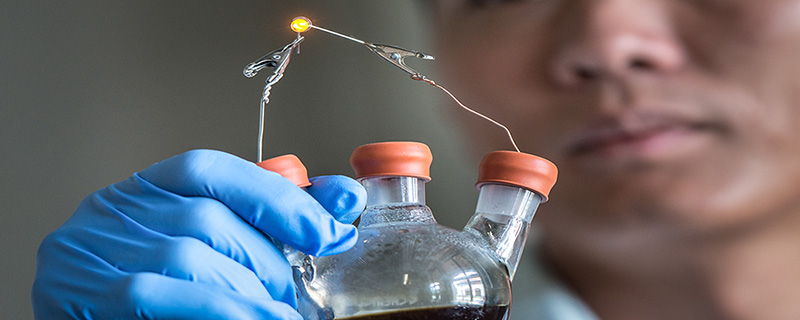Similar to previous years, the Intersolar Europe was again divided into the solar exhibition and the EES – Battery, and Energy Storage Systems. One company we came across in the EES section was Aquion Energy.
From the increasing size of the EES exhibition, it is an obvious trend that most technology developments are now taking place in energy storage!
While Lithium-Ion technology is the dominant battery technology (with LG the Intersolar EES Award winner this year with its new Li-Ion Battery Cell JH3), the next wave of battery technologies will undoubtedly be so-called ‘environmental-friendly batteries’.
The booth of US-based Aquion Energy was a very interesting visit in this regard. The company has developed a saltwater-based battery, which is safe, non-toxic, and is said to be competitive in price.

Aquion Energy at Intersolar Europe
Company Background
The US-based company was founded in 2008 by current Chief Scientist Dr. Jay Whitacre.
A new storage technology takes time and money to develop. So far Aquion Energy has raised USD 190 million, with its latest raise in April this year. Venture funding comes from various sources, including Kleiner Perkins Caufield, Byers, and nobody less than Bill Gates.
The Intersolar Award finalist nomination wasn’t the first sign of recognition for the company. In 2015, founder Whitacre received the Lemelson-MIT Prize for the invention of the Aquino saltwater battery, an award worth USD 500,000.
The market for long-duration storage
With its saltwater battery, Aquion Energy aims for the long-duration energy storage market. Long-duration energy storage means storing electricity for more than six hours.
The market for long-duration storage is worth billions, an estimated USD 766 billion by 2050 (!). (Source: PV Magazine)

Aquion Energy Saltwater battery at Intersolar Europe
A market dominated by economics
The energy industry is “dominated by economics”, and regardless of the brilliance of new technology, an energy storage product has to make the economics work first.
A member of Aquion’s staff explained at Intersolar Europe that the current pricing is already competitive with established battery technologies. Further, their batteries are becoming more affordable, especially once its US factory has been fully scaled up.
So, how does Aquion Energy’s saltwater battery compare to lead-acid and lithium-ion batteries? Below is a simplified comparison:
Lead acid
Lead Acid batteries are toxic as they’re made with lead plates, and the electrolyte is made with sulfuric acid diluted in water.
+ relatively inexpensive
– energy density is relatively low
– can not be fully discharged
– don’t operate too well under high temperatures
– contain.. lead
Lithium-Ion
+ energy density is high
+ can be discharged quickly
+ lithium-ion batteries used to be expensive, however, the price is expected to come further down, especially once Tesla opens up its Gigafactory
– can’t deal with high temperatures
– comes with safety precautions
Aquion Energy
Aquion Energy’s saltwater batteries on the contrary are made with non-toxic and safe ingredients: carbon, cotton, saltwater, and Manganese Oxide (MnO), the 10th most common element on earth. Its features are:
+ can be fully discharged without any harm
+ non-toxic
+ / – pricing is competitive (needs to be confirmed after factory scale-up)
– can only be discharged slowly, not suitable for high draw loads
Long-duration energy storage
Aquion Energy aims to tackle a couple of disadvantages of the established battery technology with its simple, non-toxic, and low-cost batteries. At the same time, it’s aiming at a specific market: long-duration energy storage.
Neither lead acid nor lithium-ion battery technology seems to be the perfect match for long-duration storage, however, Aquion Energy’s batteries – made of a combination of salt water, carbon and manganese oxide -seem to be the perfect match.
Lithium-ion batteries are mostly used in portable devices and are suitable for powering electric cars, providing high power and short bursts of energy. However there’s a large market for long-term, sustained, lower-power energy for which Lithium-Ion may not be the best choice, and this is exactly the market Aquino is aiming at.







Jerry Stokes
on 14 Jul 2016Loe Tyas Basuki
on 14 Jul 2016Nick A. Mascia
on 12 Jul 2016